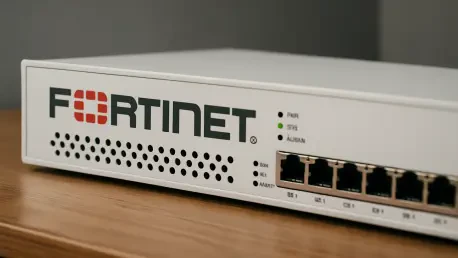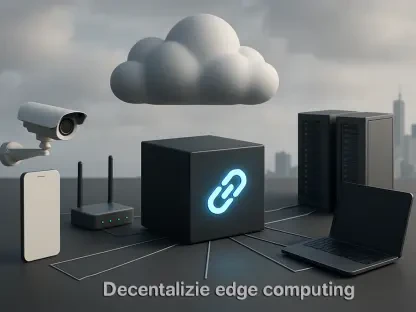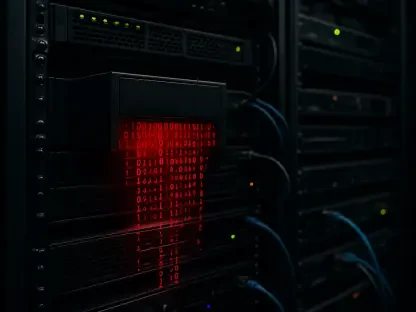In an era where cybersecurity threats loom larger than ever, Fortinet (FTNT) has emerged as a formidable force, riding a wave of explosive growth in Unified Secure Access Service Edge (SASE) and Security Operations (SecOps). As enterprises worldwide navigate the complexities of hybrid work environments and escalating digital risks, Fortinet’s strategic emphasis on integrated, scalable security solutions positions it at the forefront of the industry. The numbers are striking, with significant year-over-year billings increases in key segments, reflecting a shift toward recurring revenue and deeper customer engagement. Yet, amid this momentum, questions linger about whether this growth truly redefines Fortinet’s role in the market or if competitive pressures and financial disconnects might temper its ascent. This exploration delves into the drivers behind Fortinet’s success, its alignment with industry trends, and the challenges that could shape its trajectory in a fiercely contested landscape.
Fortinet’s Growth Drivers
Unified SASE and SecOps Momentum
Fortinet’s recent financial performance paints a picture of robust expansion, particularly in its Unified SASE and SecOps segments. In the second quarter of the current year, billings for Unified SASE surged by 21% compared to the previous year, while SecOps billings skyrocketed by an impressive 31%. Together, these segments accounted for 35% of total billings, underscoring their pivotal role in driving revenue. This growth isn’t merely a numbers game; it signals a strategic pivot toward recurring revenue models that ensure sustained income streams. Enterprises increasingly seek comprehensive security solutions that adapt to dynamic threats, and Fortinet’s ability to meet this demand through these offerings fosters deeper customer relationships. The focus on subscription-based services also reflects a broader shift in how cybersecurity is consumed, prioritizing flexibility and long-term value over one-off purchases.
Beyond the financial uptick, this momentum in SASE and SecOps highlights Fortinet’s knack for addressing critical pain points in enterprise security. As businesses grapple with distributed workforces and cloud-centric operations, the need for seamless, integrated protection has never been more urgent. Fortinet’s offerings in these areas cater directly to such needs, providing tools that secure access and operations across diverse environments. This alignment with customer priorities not only boosts billings but also cements Fortinet’s reputation as a go-to provider for modern security challenges. However, while these segments fuel growth, the broader question remains whether they can propel the company beyond incremental gains to a position of market dominance, especially in a field where innovation cycles are relentlessly fast.
Integrated Security Platform Advantage
At the heart of Fortinet’s competitive edge lies its Security Fabric platform, underpinned by the FortiOS operating system, which integrates a wide array of SASE components. This includes next-generation firewalls, SD-WAN, Zero Trust Network Access (ZTNA), secure web gateways, and more, all operating within a single framework. Such unification drastically reduces both cost and complexity for customers, a significant advantage when compared to patchwork solutions from multiple vendors. Enterprises benefit from streamlined management and enhanced security coherence, whether protecting on-premises infrastructure or cloud-based assets. This approach not only simplifies deployment but also ensures that security policies remain consistent across hybrid environments, a critical factor in today’s fragmented IT landscapes.
Further distinguishing Fortinet’s platform is its ability to deliver high-performance security without sacrificing affordability. The integrated nature of the Security Fabric allows for efficient resource use, cutting down on the overhead often associated with disparate systems. This cost-effectiveness resonates strongly with businesses under pressure to optimize budgets while bolstering defenses against sophisticated threats. Moreover, large deals—transactions exceeding $1 million—have seen over 50% growth in value, indicating that enterprises trust Fortinet to handle complex, high-stakes security needs. Still, maintaining this technological and economic advantage requires constant innovation, especially as competitors strive to close the gap with their own integrated or specialized offerings.
Industry Trends and Strategic Fit
Zero-Trust and Hybrid Work Demands
The cybersecurity landscape is undergoing a seismic shift, with zero-trust architectures and hybrid work models becoming essential for enterprise survival. As organizations ditch traditional perimeter-based security in favor of continuous verification, the demand for solutions that secure every user, device, and connection has surged. Fortinet’s FortiSASE offering emerges as a timely response, blending networking and security into a cloud-delivered service that supports distributed workforces. This alignment with industry imperatives is evident in management’s optimistic outlook, reflected in a raised billings forecast boosted by $100 million at the midpoint for the current year. The push toward hybrid environments has made such adaptable, high-performance tools indispensable for maintaining business continuity amid evolving threats.
This trend isn’t just a passing phase; it’s a fundamental redefinition of how enterprises approach security. Fortinet’s ability to provide scalable solutions that address remote access, cloud adoption, and endpoint protection positions it as a leader in this transformation. The FortiSASE platform ensures that security doesn’t become a bottleneck for operational agility, a concern for many businesses scaling hybrid setups. However, staying ahead in this space demands more than just meeting current needs; it requires anticipating future shifts in work patterns and threat landscapes. Fortinet’s current traction is promising, but the rapid pace of digital evolution means that complacency could easily erode even a well-established lead in this critical area.
Proactive Expansion through Acquisitions
Fortinet’s forward-thinking strategy extends beyond organic growth, as evidenced by its acquisition of Suridata.ai in May of the current year. This move significantly enhances its capabilities in SaaS security, an increasingly vital area as enterprises rely heavily on cloud-based applications. By integrating Suridata.ai’s expertise, Fortinet strengthens its ability to protect against vulnerabilities in software-as-a-service environments, a growing concern amid widespread cloud adoption. Such acquisitions signal a proactive stance, ensuring that the company remains relevant in a sector where technological advancements and threat vectors evolve at breakneck speed. This strategic expansion broadens Fortinet’s portfolio, offering customers a more comprehensive suite of tools to safeguard their digital ecosystems.
Additionally, this acquisition underscores Fortinet’s commitment to staying ahead of market curves through calculated investments. Enhancing SaaS security not only addresses a pressing enterprise need but also fortifies Fortinet’s position against competitors who may lag in this niche. The ability to anticipate and adapt to emerging security demands through such strategic maneuvers is a testament to Fortinet’s long-term vision. Yet, integrating new technologies and ensuring they deliver seamless value to customers is no small feat. The success of such acquisitions will hinge on how effectively Fortinet can blend these capabilities into its existing offerings without disrupting the user experience or diluting its core strengths.
Challenges and Competitive Landscape
Rivalry with Cisco and Check Point
Despite Fortinet’s impressive strides, the cybersecurity arena is far from a solo race, with heavyweights like Cisco Systems and Check Point Software presenting formidable challenges. Cisco leverages its dominance in networking to offer enterprise-grade security solutions, bolstered by acquisitions like Splunk that enhance its threat protection and scalability. Meanwhile, Check Point stands out as a pioneer in firewall technology, often surpassing Fortinet in specific benchmarks such as malware and phishing prevention through real-time threat intelligence and centralized management. These competitors bring deep expertise and broad portfolios, posing a constant threat to Fortinet’s market share, particularly in segments where specialized performance or network integration takes precedence over cost efficiency.
Fortinet’s response to this rivalry lies in its cost-effective, integrated model, which appeals to enterprises seeking to streamline security without breaking the bank. However, maintaining this edge requires more than just pricing advantages; it demands continuous improvement in performance metrics where competitors excel. While Fortinet carves out a niche with its unified platform, the pressure from Cisco’s network-centric approach and Check Point’s precision in threat prevention means that any misstep could cede ground. The competitive landscape thus serves as both a motivator for innovation and a reminder of the high stakes involved in sustaining growth amidst such established players.
Financial Outlook vs. Stock Performance
On the financial front, Fortinet projects a promising horizon for the current year, with revenue expected to grow by 12.8% to $6.72 billion and earnings per share anticipated to reach $2.51, marking a 5.91% increase from the prior year. Total billings are also forecasted to rise by 13.9% to $7.44 billion, reflecting strong enterprise adoption and analyst confidence through recent upward revisions. These figures suggest operational strength and a solid trajectory, driven by the surging demand for SASE and SecOps solutions. Yet, this positive outlook stands in stark contrast to the company’s stock performance, which has declined by 19% year-to-date, underperforming compared to an 8.6% gain in the broader security industry.
This disconnect between financial projections and market valuation raises critical questions about investor sentiment. Fortinet’s high Price/Book ratio of 28.45X, well above the industry average of 20.4X, contributes to a Value Score of D, hinting at potential overvaluation. Coupled with a Zacks Rank #3 (Hold), the stock’s near-term investment appeal appears muted despite operational successes. This disparity suggests that while Fortinet excels in growth metrics, market perceptions and competitive pressures may temper enthusiasm. Investors must weigh these valuation concerns against the company’s undeniable momentum, as the path to translating operational wins into stock gains remains fraught with uncertainty.
Reflecting on Fortinet’s Path Forward
Looking back, Fortinet demonstrated remarkable strides in harnessing the potential of Unified SASE and SecOps, aligning its offerings with the pressing demands of a hybrid, threat-laden digital world. The company’s integrated platform and strategic acquisitions carved a distinct space in a competitive market, even as financial projections painted a picture of sustained growth. However, the journey was not without hurdles, as stock underperformance and high valuations cast shadows over its achievements. Moving forward, Fortinet must focus on translating operational success into market confidence by addressing valuation concerns and sharpening its edge against rivals. Continuous innovation, particularly in emerging areas like SaaS security, will be crucial, alongside efforts to balance cost efficiency with top-tier performance. As the cybersecurity landscape evolves, Fortinet’s ability to anticipate enterprise needs and adapt swiftly could solidify its standing, turning past momentum into a lasting legacy of industry leadership.









